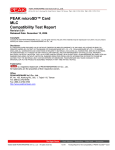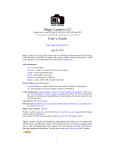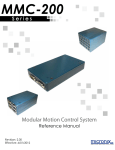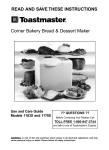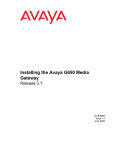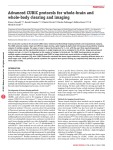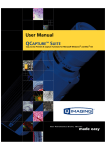Download Q Imaging Retiga EXi Specifications
Transcript
MetaMorph Imaging Handbook Update 6/4/13 Startup FIRST turn on mercury lamp (Fluorescence) Computer and monitor Qimaging Camera (on top) Uniblitz Shutters-2 Halogen Lamp (Transmitted Light) Computer Login net id and netid password Domain is Cornell MetaMorph options MetaMorph- normal use Offline-computer only Check out microscope Light path to correct camera vs eyepieces Mechanical shutter open Zoom set to 1 Filter turret – check filters installed, change if necessary DIC filters and ND filter out Objectives: dry: 4x, 10x, 20x, oil: 40x, 60x, 100x, H2O: 40x w/ cover slip, 40x dipping Iris diaphragm on 100X oil obj - open Main Taskbar If you lose the Main taskbar, go to Journal –Taskbars-Load Taskbar Look in C:\MM\Taskbars\Main.JTB HELP Use the F1 key to get help on any active menu. Choose Dialog for an explanation of all entries. MetaMorph help.pdf on website Shutdown Check Calendar before shutting down Exit Metamorph Leave Main Taskbar open Transfer files Logoff Windows Turn off camera (on top) Turn off shutters(2) Turn off monitor Turn off halogen lamp Turn off mercury lamp last Wipe oil off objective with lens paper Cover microscope *Note that Hg lamp must cool for 15 min before restarting Shutters Check shutters using shutter buttons in Main Taskbar Make sure shutter is set to NC = Normally Closed on shutter control box You may have to hit the Reset button on the shutter control box General Procedure Find your sample and focus Send light to camera by pulling out lower camera knob on right all the way In Taskbar: Choose QImaging camera Acquire window: Choose Setting- select correct shutter Select exposure time or try Autoexpose Hit Show Live Adj. focus, exposure time and/or 12 bit grey scale Unclick Saturation warnings if not wanted (may have to click 2x) Acquire (shutter will open and close) Save As (from Main Taskbar) 1 Acquire (Main Taskbar) Settings (lower left) Select fluorescence or transmitted. This chooses the shutter as well as exposure time, 12 bit adjustment, binning, gain, offset, etc. You can save your settings with the same name or a new name. Display Tab Spread Triangles to ends, adjust as needed. Right triangle makes pixels whiter, left makes background blacker. Middle is gamma, keep at 1 Special Tab The Qimaging camera has a gain, offset and speed control. Gain ranges from 1 to 30. If you have dim images, increasing the gain will give you higher signal at the same exposure. Higher gains also have higher noise. Start with gain of 1. Offset controls your black level. Keep between 10-50 to avoid ‘too black’ pixels. Digitizer has values at 2.5, 5.0, 5, 10, 20 MHz. This is the speed of the camera readout. Higher speeds have more noise. For very low signals, a slower speed will give you a higher signal-to-noise ratio. Generally use 10 or 20 MHz. Acquiring an Image Show Live—Shows a live image on the computer screen for focusing or X-Y adjustment. Use this to focus and set exposure time. Acquire button at top—uses whatever size image was last used. Options: Full Chip—1317 x 1035 pixels. Acquires the largest image field Center Quadrant—658 x 517 pixels. Acquires the center 1/4 of the image field Acquire Active Region—You must have an active region defined on an image Troubleshooting No light in microscope -- lower knob should be pushed in to send light to eyepieces -- toggle shutter ON from Main Taskbar -- set shutter to NC on shutter control box -- hit Reset button on shutter control box -- check to see if the lamp is on -- mechanical shutter must be open for fluorescence (in light path behind filter cubes) Image on screen all black --lower knob should be pulled out to send light to camera --upper knob should be in to send light to Qimaging camera --set shutter to NC on shutter control box --hit Reset button on shutter control box --check shutter listed at lower left of acquire window or in Acquire tab of same window --try a longer exposure Image too bright or is all white --reduce exposure time, a lot --Reduce gain (under special tab in acquire window) --Send less light to camera by using the middle position on the lower knob (50% less) and the middle position on the upper knob (together 75% less) 2 Image Processing 12 bit Images Collecting images with 12 bits (4096 gray levels) is useful when you are doing quantitative work, complex image processing, especially involving thresholding, or when you have very low light levels or high background. Adjusting 12-bit images Use the triangles (under Display in the Acquire window) to adjust the white and black levels. (This is just like Photoshop using Image-Adjustment-Levels.) The left triangle chooses the level of grey that will be absolute white and the right triangle sets the grey level below which everything will be black. You lose some of your grey levels but as you start with 4096, this is generally OK. Do not adjust so far that you have less than 256 levels left. Use a longer exposure when this happens. When you convert to 8-bit, these adjustments become permanent and you will have 256 grey levels. You can also adjust the gamma but use this with care as it makes the relationship between brightness and fluorophore concentration non-linear. Always use gamma=1 if you want to make any brightness comparisons between images. Scale Image (Main Taskbar) will adjust a previously acquired image. Choose image. Select the 12-bit 4096 grey levels. Image Quality You should always avoid saturating pixels, as information is lost and can never be retrieved. When you adjust your 12-bit images, do not make them too bright and also do not make them too black. The area outside the triangles is lost when you convert to 8-bit and can never be retrieved (unless you save the 12-bit images). Further adjustment of the 8-bit image is possible with Photoshop. Image Noise If your images are grainy, try using a lower gain or a slower speed and increasing the exposure time. You may also want to try 2x2 binning if resolution is not an issue. This creates a larger pixel size but decreases your exposure time. 8-bit Images To automatically acquire 8 bit images, click on Acquire 8 bit on the Main Taskbar. To retain the ability to do 12 bit adjustments but only save 8 bit images use the copy to 8-bit option in the Main Taskbar. This converts and saves the image as 8-bit. Convert all files to 8 bit Or you can convert all images later using the copy DIR to 8-bit option. This will convert all images in one folder automatically. The 12-bit images are overwritten. To keep the 12 bit images, make a copy first. (See also Image Color, below.) Image Zoom Use magnifying glass on each image and right and left mouse buttons to increase or decrease zoom. Unclick to deactivate. This will be used on the next acquired image. Scroll wheel on mouse also zooms, you may have to wake it up. Image Cropping Select square in Toolbar -- Draw region on image 3 Save Partial, to save just the defined region without re-acquiring To use this region again, use acquire active region on image. Overlay Images (Main Taskbar) Collect images sequentially using different filters or transmitted light Choose # images = 4 or more Choose an image for each color (use black for transmitted light image) Click on Show preview and move preview box around. You can adjust color balance, or brightness if desired, or you can adjust your original images and see the changes live in the preview window. If you do adjust the original images, consider whether you have saved them, need to resave them, or don’t want to change them, You can do a pixel shift here if the images do not line up properly but most likely you bumped the scope and you should re-acquire the images. Note that a DIC image may change the alignment. Apply -- This creates a 24-bit RGB TIFF and does not need to be converted to 8-bit. Saving Image Color Overly images will always be in color. If you want green-black, red-black or blue-black images, you can add color with the rainbow at the left side of each image. Note that this color will be used for the next acquired image. Duplicate as Displayed (Main Taskbar) will save the images in color. This converts to a 24-bit RGB image (same as an overlay) so your 12-bit adjustments will be permanent. Both images are on the screen and you can save both at this time. Or Leave the image in grey scale and use the Overlay feature (main taskbar). Put the image in the color desired and apply. This also saves a 24 bit RGB image. Scale Bar Always save the image first If you did not save the magnification with the image you must calibrate the image: Measure Menu--Calibrate distance Load calibration file (C:\MM\app\mmproc\data\distance.CAL Choose correct objective and zoom and click on Apply Can apply to all open images to calibrate many at once, or Leave menu open and apply to each image if desired For the Motic camera, load the file that matches the image size in pixels that you used. Create a scale bar as follows: Display Menu -- Graphics -- Calibration Bar Adjust length, thickness and label When choosing color, remember that white = 4095 (12 bits) or 255 (8 bits) Look for the bar in the lower right corner, you may have to scroll to find it Stamp Calibration Bar to see what it will look like. If you want to change it, Undo immediately. You may want to save with a different name. The bar is permanent. 4 Image Information File-Open, highlight any file name, will give exposure time, bit depth, image size, magnification, binning, gain, offset, speed, etc. OR— Open image Edit menu –Image Info—gives above info and more. Click on any file to see thumbnail image. Not with 12-bit images. Saving and Naming Images Images save in TIFF format. The .tif. is added automatically. Do not compress your images. Opening and closing compressed images causes loss of information over time. There are several ways to save an image. ---Use Save As in the Main Taskbar This is the same as File-Save as ---The most recently acquired image can be saved with the button in the Acquire window that says Save new01 or whatever number you are on. This button cannot be used for previously acquired images. Name the image if desired. ---To save several images with the same base name, eg goodexpt01, goodexpt02, etc: Check Save w/sequence. Click on Set Save and set the base name and folder. Click on Save basename01 and it will save with this name. Only the most recently acquired image can be saved with this method. You can skip images, but you cannot go back. To save as 8-bit images immediately, click on Copy to 8-bit in the Main Taskbar. This works with any open image, not just the most recently acquired. MIF Server Copy your files to our fileshare ( Z: drive) and retrieve them soon via information provided on the User Info handout. Both the hard drive and the server have limited space. Please delete your files when you have backed them up. After 1 month, your files may be deleted. 5 Transmitted Light (Bright Field) Introduction You can collect a bright field image of the same region as the fluorescent image to aid in localization of your fluorescence. The bright field image can be overlaid (merged) with the fluorescent image(s), see Image Processing. Note: Adjusting the microscope for an optimal bright field image is more complicated than fluorescence. It is highly recommended that you ask for help the first few times. Kohler Illumination Technically, this must be done each time you switch objectives. Focus on your specimen in the microscope. Close the field stop diaphragm at base of microscope. Adjust the height of the condenser until the aperture is sharply focused. Center the aperture with the centering screws. Open the field stop until the light just fills the field and the aperture is no longer visible. Close the condenser diaphragm part way for desired contrast. Focal Plane The focal plane you choose for bright field or DIC may not be the same as for fluorescence. You should check focus between acquisitions. Remember to change shutter Differential Interference Contrast (DIC) – Nomarski DIC is a method of enhancing the contrast of a bright field image. It has optical sectioning qualities and is very good for viewing surfaces. The effect looks similar to a scanning EM image, with a black ‘shadow’ on one side and a white ‘shadow’ on the other side. The ‘shadows’ are formed by differences in refractive index or by differences in height. Microscope Set Up for DIC First follow procedures above for Kohler illumination. The upper polarizer (often called the analyzer) found on the right side of the microscope just below the zoom wheel must be pushed in. The Wollaston Prism, just above the objectives, must be pushed in. The polarizer below the stage must be in place and aligned 90 degrees to the analyzer. It usually is in place. The condenser must be set for the objective being used. There is a setting for each objective except the 4x and 10x. The condenser diaphragm should be fully open. Wollaston Prism The Wollaston Prism (just above the objective) has a screw, which can be adjusted for desired contrast. The full range of the screw is such that the image is darkest in the center and brighter near the ends. The difference between the two sides is the direction the ‘shadows’ fall on. The optimum setting is usually somewhat off center on either side. Note that the use of this prism may cause a pixel shift, which could be an issue when overlaying with a fluorescence image. 6 Image Analysis -- Measure Menu Updated for new software. This is a brief overview. There are lots of things not mentioned here. Defining Regions Define region(s) with box or other drawing tool from Region Toolbar. User Traced Line to click-draw any shape See Region Tool Properties (last icon on Region Toolbar) for other settings To delete active region, hit del key. You can shrink, save, move, transfer, label, and color regions. See Region menu, Region Toolbar and Edit-Preferences-Regions Region Statistics Choose source image Check to use entire image or active region. Spatial Stats: area, height, width, perimeter, etc. in pixels or um You must calibrate the image to get values in microns. Intensity Stats: ave, st dev, integrated, min, max. etc. Can use + / - threshold See Threshold, below Intensity measurements are generally best with single color images Region Measurements This is used for more than one region Choose + / - threshold, all regions, active region, or entire image Configure to choose desired measurements. Includes morphometry and intensity levels Intensity measurements are generally best with single color images Threshold Icon on left toolbar or under measure menu Choose auto threshold for light objects and adjust orange bar in left toolbar Set transparency of threshold to see objects underneath The threshold menu will give you numbers (?) Try zooming up to 200% to set Color Threshold Best for real color bright field images Choose color range: HSI, HSL, RGB (Hue, Saturation, Intensity, Luminosity) Set by example uses mouse clicks on image to choose colors, go slow as you can only undo one click. Cut / Join Objects Use icons in OverlayToolbar at top See Overlay Properties (last icon in overlay toolbar) Center of cross is where line goes. Do in 200% zoom Integrated Morphometry Analysis Must have a threshold. You can threshold the entire image Calibrate the image to get values in microns, otherwise you can use pixels Select Measurements Choose desired parameters to measure They are listed but you must check Display to see the data You can set filters for one or more measurements (see below) 7 Hit Measure (at bottom) Objects measured will be green with white border. Border is an option under Preferences Object Data—display of data Click on any data point to highlight object on image or vice versa Double click to remove any data point/object Data Log is in this view Reset Current to delete measurements and start over. Filters Use a filter if you want to limit measurements to objects of a certain size range or grey value range. Do a measurement first, then look through your values to choose a size cutoff or average object size or intensity level Can also use histogram to set parameters Histograms Choose X-axis, Set # bins. Click on arrow in lower left of graph to change axes scales, etc Set filters for classifying by moving red lines. Click on Set Filters from Calipers Log Data Configure log Choose parameters to log. Options are dependent on measurement mode Choose log column headings. Open log, choose DDE, Excel, row, column Each time you measure, hit log data, and it will go into the Excel file. You will need a separate log file for each measurement mode, data vs summary, etc Measure Linescan--Shows the variation in intensity across any line drawn on image Histogram--Show intensity levels of image. Calipers—Measure distance and angle between objects Manually Count Objects--Marks each object after clicking with mouse. Morphometry--Measure objects-creates a new image of objects, use as a mask? Apps Menu These have specific functions but can be used for other samples Only work with 12 bit (or greater) images Can identify objects based on a local difference in intensity over background Use the mouse cursor to see the grey value of any pixel (at bottom of image window). Click on display result image to get a separate image of objects. The original image has an overlay that can be toggled on/off with green square icon at left of image. Try some setttings, make large changes, refine Example: Count Nuclei -- set minimum and maximum size and grey level over background Process Menu You may want to do some image processing to make your images easier to analyze. Median filter smooths out rough edges and intensity variations (noise, speckle) Dilate grows objects so you can join them Erode shrinks objects so you can separate them Many other options 8 Collecting a Z-Series Set Up Attach Z-motor color to coarse focus of microscope Must start MM with the Z-motor icon Use Show Live in the Acquire window to determine the best exposure for entire series Use a bright plane in your specimen Insert and tighten focus motor sleeve on right focus knob. Push in while tightening screw. Make very snug. All focusing must now be done with the small knob next to the joystick. Select Focal Planes to Collect Devices Menu – Focus Focus (with small knob on joystick) to lowest focal plane you wish to collect. Click on Set Origin to make this position = 0 Click on Set Bottom Focus slightly lower For highest accuracy: Click on Set Home Collect against gravity, bottom to top. Focus to highest desired focal plane This is in the negative direction. Click on Set Top Close shutter Return to a lower position than the desired starting position if you will repeat with another filter. Set # of planes or spacing Acquire Menu -- Acquire Z-series Note: Image storage: set to stack Moving the focus knob towards you will Choose shutter move the stage down. Start at -- bottom Move to -- Top After -- Home Choose number of planes desired - or - number of microns between planes OK to start collecting Calibration: 1um =10 steps Viewing / Processing a Stack Stack Menu Select Planes Remove Planes Compress into one image (Projection) Under 3-D reconstruction -- choose angle = 0 3-D Reconstructions Movie—to watch Make Movie—to make an AVI or Quicktime movie Use 5 or 6 (/30) frames per second No compression or try Cinepak at 100% or IndeoVideo at 100% or 50% Building a Stack or Montage File menu – Open Special -- Build Stack Use Numbered Names or Quick Click on first file Click on last file 9 Timelapse Imaging – Basic Choose in Main Taskbar For transmitted light or fastest times, use none for shutter Interval—shortest is ~400msec, accurately Uncheck time reporting Set time or number of frames There is a maximum file size based on RAM of about 10 min at 0.5msec To go faster or longer Uncheck viewing Use center quad Use binning Use 0 Interval, but times may be uneven (you can get the values) Save as .stk Timelapse Imaging -- Advanced This method does not have a RAM limitation? Can go faster? Apps – Multidimensional Acquisition Main, choose Timelapse only Saving, pick basename and folder for saving Wavelength Set Gain to 1 Set exposure time (match the acquisition window) Use 20MHz (fastest) Timelapse Interval Set duration or number of frames Summary, to review Acquire here This saves a .nd file which can be opened in Metamorph and is like a .stk Also saves individual .tif for each time point and some sort of thumbnail image for each time point Stream—this seems to crash the software You can also collect a Z-series at each time point with this method Note that the Motic camera cannot collect faster than 1 sec intervals Both Use Stack menu to manipulate To get time stamp: Display – Graphics – Elapsed Time Stamp onto first image Save as stack? or Stack – Movie Save as .AVI 10 PhotoShop (ver 5.5 or 6.0 of 7.0) with Metamorph Enhancing Contrast or Adjusting Colors Image--Adjustment--Levels choose RGB or individual color use the histogram to adjust brightness, black level, and gamma After adjusting, you should save with a new name. The contrast changes you make are permanent and if you don’t like the printout, you will want to start with the original image, not the adjusted one. Always save the original image. 12-bit files (This doesn't always work, for reasons unknown) Image will open all black. Image--Adjustment--Levels Move right-hand triangle down to about 25, hit OK This essentially converts to 8-bit Image--Adjustment--Levels Now you should see a broader histogram Adjust brightness, black level and gamma as desired. Save with a new name as explained above. Or, go back to MetaMorph and convert to 8-bit Coloring Images To make a Red/Black or Green/Black image from greyscale. Open image Image--Mode—choose RGB Color Image--Adjust--Levels Choose colors not wanted Drag left triangle under histogram all the way to the right to eliminate this color Repeat with other color not wanted. You will be left with the desired color. Adjust as above. Save image (You can get rid of the color by changing Mode back to Grayscale) Saturated pixels will turn white with this method. To avoid this, try the following method: Image--Mode--RGB Color Image--Adjust--Hue/Saturation Check Colorize Saturation at 100% is probably best Adjust Hue to ~120 for green, red is the default Lower Lightness to color white areas and darken background Save image Or use Duplicate as displayed in MetaMorph. 11 Specifications Microscope: Olympus BX50 Camera: QImaging Retiga Exi cooled CCD camera 1392 x 1040 pixels Software: Metamorph Premier ver 7.7.5 from Molecular Devices, Inc. Filters for the Olympus / Metamorph Digital Imaging System Standard Filter Turret Name Dyes Type Wavelengths Range Cat # UV DAPI Hoechst 360 / 40 400 DCLP 460 / 50 470 / 40 500 DCLP 515 LP ET560 / 40 585pxr 630 / 75 ET470 /40 495pxr ET525 / 50 340-380 31000 Chroma FITC Alexa 488 also red TRITC mCherry Texas Red GFP Alexa 488 FITC Excitation Dichroic Emission Excitation Dichroic Emission Excitation Dichroic Emission Excitation Dichroic Emission Name Dyes Type FR Cy 5 FITC+ Green/Red Red 435-485 450-490 515+ 540-580 11001 Chroma 49008 Chroma 695-665 450-490 NEW 11'11 500-550 NEW 11'11 Wavelengths Range Cat # Excitation 620 /60 590-650 41017 Alexa 633 Dichroic 600 Alexa 647 Emission 700 / 75 662-737 Cyan Excitation 436 / 20 426-446 Fluorescent Dichroic 455 DCLP Protein Emission 480 /40 460-500 Yellow Excitation 500 / 20 490-510 Fluorescent Dichroic 515 DCLP Protein Emission 535 / 30 520-550 Cyan-Yellow Excitation 436 / 20 426-446 FRET Dichroic 455 DCLP Emission 535 / 30 GFP 49002 Chroma GFP Filter Turret CFP YFP C-Y Chroma 31044v2 Chroma 41028 Chroma 31052 Chroma 520-550 If you move a filter cube to another location, please put it back 12 Scale Factors for Qimaging Retiga Camera with MetaMorph Obj Zoom um/ pixel pixels/ um Mag on screen Obj Zoom um/ pixel pixels/u m Mag on screen 100x 1 0.10 9.8 2800x 20x 1 0.52 1.94 585x 100x 1.25 0.08 12.28 3500x 20x 1.25 0.41 2.43 730x 100x 1.6 0.06 15.76 4480x 20x 1.6 0.32 3.12 935x 100x 2 0.05 19.8 5600x 20x 2 0.26 3.9 1170x 60x 1 0.17 5.85 1680x 10x 1 1.03 0.97 280x 60x 1.25 0.14 7.32 2100x 10x 1.25 0.83 1.21 350x 60x 1.6 0.11 9.41 2688x 10x 1.6 0.64 1.56 450x 60x 2 0.09 11.76 3360x 10x 2 0.51 1.95 560x 40x 1 0.26 3.89 1120x 4x 1 2.56 0.39 110x 40x 1.25 0.20 4.88 1400x 4x 1.25 2.04 0.49 140x 40x 1.6 0.16 6.26 1800x 4x 1.6 1.61 0.62 180x 40x 2 0.13 7.85 2240x 4x 2 1.28 0.78 225x Objectives on Olympus Microscope Objective Mag Immersion NA Working Distance Uses U PLAN APO 4x Dry 0.16 13 mm Fluor / DIC U PLAN APO 10x Dry 0.4 3.1 mm Fluor / DIC U PLAN APO 20x Dry 0.7 0.65 mm Fluor / DIC U PLAN APO 40x Oil 0.5-1.0 120 um Fluor / DIC PLAN APO 60x Oil 1.4 100 um Fluor / DIC PLAN APO 100x Oil 0.5-1.35 100 um Fluor / DIC U PLAN APO 40x H2O 1.15 260 um Fluor / DIC U PLAN APO PH 40x Oil 0.5-1.0 120 um Fluor / Phase contrast U PLAN APO PH 100x Oil 0.5-1.35 100 um Fluor / Phase contrast 13













